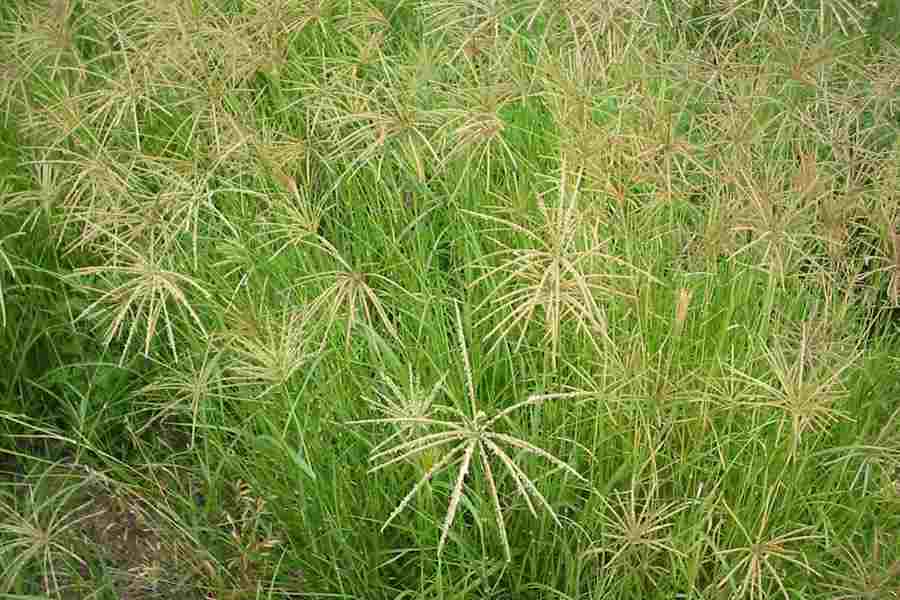Rhodes grass (chloris gayana)

Rhodes grass (chloris gayana) is a leafy perennial grass which grows to 30 to 150 cm in height. Their roots have stolons and therefore spread easily in the field.
The grass is extremely adapted to a wide range of ecological conditions and therefore grows in many parts of the country. It can tolerate a wide range of soils. However it prefers well drained fertile soil and an annual rainfall between 600 and 1100mm. the grass is not suited for very dry areas or excessive moist conditions especially where the soils are not free draining. In Kenya Rhodes grass is common in medium dry lands. If well managed they give good pasture all year round.
Rhodes grass has been used extensively for pasture improvement because its seeds being easily available and being easy to establish and manage. Varieties in Kenya produce large bulk of herbage which are good for grazing and hay making. They are readily eaten by livestock even when they are mature although the nutritive value is very low at old age.
The grass is established at a seeding rate of 4 – 6 Kg per Ha. The seedbed should be fine and compact because the seeds are very small. If the seedbed is rough seeds may land in low levels and may fail to come up after germination. Compaction helps to ascertain that most levels of planting are uniform and seeds do not go far deep.
Fertilizers are required moderately. For example during planting time it may be added at 40 – 60Kg of phosphate fertilizer per hectare. If the soil nitrogen is at reasonable levels then there would be no need for nitrates. However nitrates can be applied during the second year after grazing at 60 – 90 Kg per hectare. Time should be allowed to pass before grazing to avoid nitrogen poisoning of cattle.
Yields on well managed Rhodes grass are around 5 – 8 ton/ha/year after the second year although much higher yields can be obtained. The crude protein (CP) content varies with age and nitrogen level in soil. If well managed about 7 – 11% can be obtained after the eighth week of planting.
Commercial varieties in Kenya are
- Elma bred from Mbarara Rhodes
- Boma grass bred from pokot and masaba rhode
- Kapedo Rhodes bred from N. Baringo
Elma and boma Rhodes are good for regions with good rainfall while the others are drought tolerant.
Cultivation
| Climate | Grow at altitudes from 600 to 2000 m above sea level. It does well in areas receiving rainfall of more than 250 mm annually and also persists well under drought conditions. |
| Soils | It grows in a wide range of soil conditions but performs best in loamy, fertile soils. It does not do well in alkaline or very acid soils. |
| Site | It is best grown in grazed plots or shut-up for hay making. |
| Preparation | Plough and harrow at least once to make a fne seedbed. Harrow after the weeds have emerged to reduce competition during establishment. Sow immediately after harrowing. |
| Sowing | Sowing it is usually established from seed but root splits can also be used. Te best time to sow where there are two rainy seasons is during the short rains. Where there is one rainy season, plant from early to mid rains. Sow when the soil is loose (dry). Make furrows 25 cm apart using a peg. Drill the seeds in the furrows, at a seed rate of 12 kg per hectare. Cover the seeds lightly, for example by pulling light tree branches over the furrows. |
| Fertilizer | For high productivity, apply nitrogen fertilizers preferably during heavy rains at the rate of 100 kg per hectare. |
| Weeding | Make sure the plot is weed-free during the initial period of establishment. Remove weeds between the rows using a hand hoe. |
| Pests | No diseases of importance but common pests such as army worms may attack the pastures. |
| Harvesting | Start harvesting or grazing soon after flowering. If cutting, cut close to the ground to stimulate spreading. Leave to re-grow again until next flowering. When well managed, Rhodes grass can yield an average of 8 tonmes dry matter per hectare per year. |
| Feeding | Grazing is the most common method of feeding Rhodes grass although some farmers use it for cut-and-carry. Tends to decrease in abundance on over-grazed pasture due to its high palatability. Rhodes grass is very good for hay making. It can also be used for seed production; up to 350 kg seed per hectare can be harvested. |



